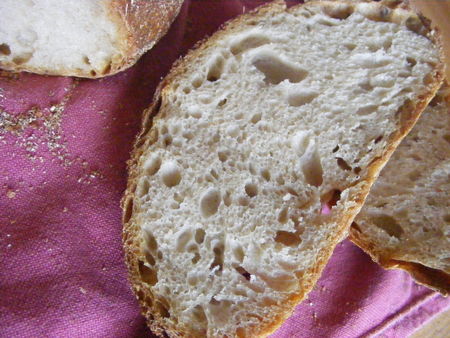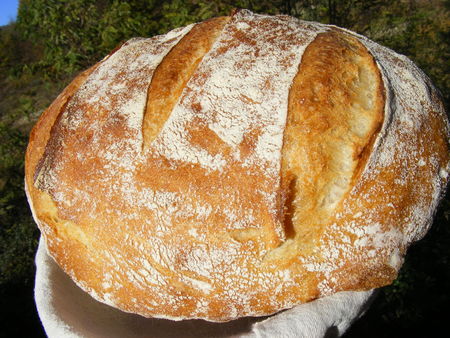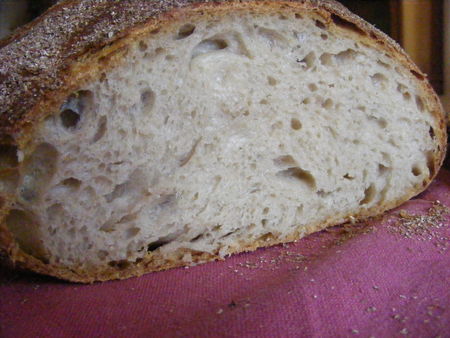Pane di Genzano et variations/Pane di Genzano with variations
C'est miraculeux!!!! Je suis revenue et j'ai trouvé le temps de rédiger une recette. Chaque billet me prend plusieurs heures de travail et j'avoue qu'en ce moment, je ne trouve pas le temps nécessaire. Mais, je n'ai pas disparu, et je ferai mon mieux pour publier. Je commence à avoir une LONGUE liste de recettes et d'idées d'article. Il faut inventer les jours de 48hrs (peut-être 24 de celles-ci sans enfants?).
It's a miracle, I'm back!!! I actually found the time to do the write up for this recipe. Every post takes me several hours to do and I have had a terrible time finding the time. But, I haven't disappeared and I will do my best to keep posting. I have a long list of recipes and article ideas waiting. Someone must invent the 48 hr day (maybe 24 of them without kids?)
J'ai depuis quelques temps le livre de Daniel Leader « Local Breads ». C'est une compilation de recettes de boulangers Europeans que Leader a adaptées pour les amateurs de boulange aux Etats-Unis. Comme les farines sont très différentes des variétés Européennes, il est arrivé à faire des mélanges de farines américaines afin d'obtenir un résultat presque pareil. Je ne peux pas vous dire s'il a réussi son pari car je ne me suis jamais servie des farines américaines, mais les recettes que j'ai déjà essayées m'ont donnée des résultats superbs.
I bought Daniel Leader's « Local Breads » a while ago. It's a compilation of recipes from European bakers that he has adapted the American home baker. As the flours are quite different from the Europeans varieties, he has managed to blend American flours in order to copy as close as possible the flours used over here. I can't tell you if he has succeeded, since I have never used American flour, but the recipes I've tried with the authentic French flour, guessing at what flours he was trying to copy, have been quite impressive.
La dernière recette que j'ai essayée de ce livre est le Pane di Genzano, un pain au levain italien de Genzano, qui, traditionnellement, est cuit jusqu'à obtenir une croûte très foncée, voir noire. Il est couvert de son de blé et sa taille est assez conséquente. Ce pain est un peu le Pain Poilâne de l'Italie et il est protégé par an AOC. Mais bon, comme avec ma recette du Pain Poilâne (ici) je sais parfaitement qu'il n'est pas possible de faire exactement la même chose à la maison. Ce pain devrait être cuit dans un vrai four au bois. Cependant, j'étais TRES contente du résultat!
My latest bake from this book is the Pane di Genzano, an Italian sourdough country bread from Genzano, that traditionally is baked until almost black. It is covered with bran and made to be very large in size. In my mind, it is the Pain Poilâne of Italy. Leader has scaled down the recipe for the home baker, but it still makes a nice size loaf. As with my pain Poilâne recipe (here), I know perfectly well that it is impossible to make a TRUE Pane di Genzano at home. I wasn't able to get a black crust (and quite frankly don't want one). This is a bread that should be baked in a wood fired oven, I think. But regardless, the results were incrdible!
Le mieux pour faire ce pain est d'avoir un mixeur électrique du style Kenwood Chef ou un Kitchen Aid. La pâte qui a un taux d'hydratation élevé, subit un pétrissage assez agressif et long. J'étais assez sceptique car depuis un bon moment je privilégie un pétrissage très doux et assez court, mais quand j'ai vu le pain, ça m'a étonnée. En début de pétrissage la pâte est presque liquide (OK, j'exagère, très très molle) et petit à petit elle forme une boule, mais que dès que le mixeur s'arrête retombe au fond de la cuve. A la main, il faudrait du temps et les mains seraient couvertes de pâte! La recette demande une biga naturale (un levain ferme) et de la levure est ajoutée au moment ddu frasage. La pâte a beaucoup levé et j'avais peur que le pain sente la levure. Avant d'aller au four la pâte était super gonflée et presque vivante! Leader n'a pas dit de faire des incisions, mais comme il y en avait dans sa photo j'en ai faites. Je n'ai pas pu m'empêcher de regarder une ou deux fois lors de la cuisson tellement j'étais curieuse. C'était une nouvelle aventure pour moi. A la sortie du four, j'étais assez impressionnée. Le pain était foncé sans être noir et il a bien gonflé au four. Il dégagé un parfum sublime et il m'a chanté une chanson. Quand je l'ai tranché (après une durée assez longue pendant laquelle j'ai du montrer beaucoup de patience) la mie était très aérée et alvéolée avec une bonne élasticité. Le goût? Superb!
To make this bread, you really need an electric mixer with a hook. The dough, which is highly hydrated, undergoes a fairly aggressive kneading for an extensive period of time. I was a bit sceptical, since I have been making bread that use a more gentle, shorter kneading, but after seeing the bread, I was amazed. At the beginning of the kneading the dough was so wet and sloppy, but little by little it came together to form a ball. When the machine is stopped, it falls back down to the bottom of the bowl. The recipe uses a biga naturale and then yeast is added to the dough. The dough rises a great deal and I was worried it would have a yeasty taste. Before going in to the oven, the dough was almost alive, very leavened and almost wobbly. Leader didn't say to score it, but I did because in the pictures in the book, it had a few slashes. I couldn't help peaking during the bake because this was a new frontier for me. When it came out of the oven, I was truly impressed. The bread was dark (though not black), had great oven spring and smelled delicious. This bread sung. On cutting (after a patient wait), the crumb was incredibly light and airy, with a beautiful open crumb, yet elastic as a sourdough should be. The taste... simply wonderful.
Version Kamut/Kamut version
Mais comme d'habitude quand je fais un pain "blanc" avec une nouvelle technique, j'ai envie de voir ce qui se passerait avec d'autres farines plus intéressantes. Au courant d'une semaine, j'ai essayé cette recette avec différentes farines. J'ai crée une biga naturale le soir, mais sans suivre la recette initiale,mais en faisant une jolie pâte, qui a levé toute la nuit. Le lendemain, sur une base de 600g de farine, j'ai essayé des mélanges différentes. Parmi eux: T55 + 100g de seigle/T55 + T110 + seigle/ Kamut + T65/ que T65. J'ai gardé le 3/4 cc de levure mais j'ai essayé avec moins aussi. J'ai ajouté de l'eau sans mesurer pour obtenir la consistance de pâte que je voulais. Chaque fois, le pain était très bon. Cette recette est donc plus rapide mais le pain a un goût excellent et complexe, bien que plus discret qu'un vrai pain au levain.
But as usual, when I make a « white » bread with a new recipe, I wonder how it would work with some more interesting flours. Over the course of a week or so, I made up this dough a number of times, leaving the initial recipe behind and using different flours. I created a biga naturale in the evening, not measuring, just making a nice dough, letting it rise over night. Then in the morning, using 600g as a base for the flours, I tried a blend of white with some rye (about 100g), or white with T110 and some rye, Kamut with some T65 or T65 alone. I kept the ¾ tsp of yeast but tried with less as well. Then I added water until I got the perfect consistency. Each time, the bread was excellent. This recipe is great for a faster bread with a nice, thoughmore subtle, sourdough flavor.
Voici donc la recette originale:
So, here is the original recipe from the book.
Pane di Genzano by Daniel Leader
Le matin de la veille/The morning before:
Rafraîchissez le levain pour en créer un ferme. Laissez fermenter toute la journée.
Feed your starter to create a firm starter. Let ferment until the evening.
Le soir de la veille/The evening before:
Biga Naturale
28 g levain ferme/firm starter (30g would be FINE!)
140 g eau/water at about 70-78 °F
200 g farine T55/white unbleached flour
Le jour de la cuisson/Bake day morning:
La pâte/The dough
368 g toute la biga naturale (all of it)
400 g eau/water at about 70-78°C
500 g farine T55 + 2 cs gluten en poudre/high gluten unbleached bread flour (I used T65 and added 2 tbsp vital gluten
4 g levure sêche/instant yeast
15 g sel gris moulu/sea salt
Pour le banneton/for the banneton
15 g son de blé/bran
Pétrissage/Kneading
Mettez la biga naturale dans le bol du mixeur et ajoutez l'eau. Remuez pour ramollir la biga.
Put the biga naturale in the bowl of the mixer and then add the water. Stir to break up the biga.
Ajoutez les autres ingrédients et mélangez pour former une pâte (frasage).
Add the other ingredients and blend until a wet dough forms.
Allumez le mixeur et faites tourner à vitesse moyenne/vite pendant 10 minutes. Surveillez le mixeur car parfois il peut se délacer et tomber.
Turn on the mixer to medium-high speed and let knead for 10 minutes. Be careful because as the dough forms, the mixer can start to move and fall off the counter.
Augmentez la vitesse et continuez encore 8-10 min. Leader explique que la pâte commencera à former des fils qui petit à petit deviennent plus gros. Je l'ai bien vu. La pâte se détachera des bords et former une boule mais quand le mixeur s'arrête, la pâte retombe au fond de la cuve.
Increase the speed to high 8-10 minutes. Leader explains that the dough will start to form stringy strands and then thicker ones, which is exactly what happened. It will eventually pull away from the side of the bowl and form a ball, but then slide back down if the mixer is stopped.
Faites une vérification du développement du gluten en prenant un petit morceau et en l'étirant. Si elle ne se déchire pas et vous arrivez à obtenir une sorte de fenêtre, c'est bon. Sinon, continuez un peu plus longtemps.
Do a windowpane test to make sure the gluten is formed enough.
Fermentation:
Transférez la pâte dans un bol légèrement huilé, couvrez et laissez fermenter 1 ½ hrs. Faites un rabat (sans sortir la pâte du bol, enfoncez votre poing mouillé dans la pâte, puis soulevez les bords et les pliez vers le hautTransfer the dough to an oiled bowl, cover and let ferment 1 ½ hrs. Punch the dough down and pull up the side (I did a few folds, using my hand as a spatula).
Couvrez et laissez fermenter encore 1 – 1 ½ hrs. Cover and let ferment another 1 – 1 ½ hrs.
Façonnage/Shaping:
Parsemez du son dans un banneton. Sortez le pâton du bol sans le déchirer et dégazez-la. Formez une boule assez serrée. Je trouve que cette pâte supporte d'être farinée et manipulée et comme elle lève bien grace à la levure, il vaut mieux former une boule serrée. Placez lae pâton dans le banneton, clé vers le haut. Couvrez et laissez fermenter encore1 ½ - 2 hrs.
Sprinkle a good amount of bran on the inner lining of a banneton. Take the dough out of the bowl without tearing it and then degas it and form a tight ball. Leader says to handle as little as possible, but I've found that this bread does accept some flouring and handling, if you're used to and not scared of this kind of soft dough. With the yeast and the large amount of levain, it needs quite tight shaping because it rises very easily. Place the dough with the seam up in the banneton.
Cover and let rise until doubled, about 1 ½ - 2 hrs.
N'oubliez pas de préchauffer le four à 250°C avec la pierre à pain et le lèche frite en place bien une heure avant la cuisson.
Don't forget to preheat the oven about an hour before baking. I heat to 250°C with the baking stone and a metal pan in place.
Cuisson/Baking:
Couvrez la pelle à pain avec une feuille de papier cuisson. Retournez le pâton sur la pelle et faites trois incisions. Faites un bon coupe de buée et faites glisser le pâton sur la pierre. Laissez cuire 30 min, puis baisser la température à 210°C. Laissez cuire encore 20-30 min. jusqu'à ce que la croûte soit bien foncée (jamais pour moi!)
Cover a peel with some parchment paper and turn the dough over on to the peel with the seam down. Cut a few slashes across the top. Leader does the ice cube thing, but I really couldn't be bothered and don't find a difference. With my oven, a good initial steaming is enough. I pour some hot water in my pan placed at the bottom of the oven (and which never comes out!)
Slide the dough with the parchment paper on to the stone. After 30 minutes turn the oven down to 210°C and bake another 20 -30 minutes until very dark.
Refroidissement (Ressuage)/Cooling:
Laissez refroidir au moins deux heures sur une grille avant de couper.
Let cool on a rack around two hours before slicing.


/https%3A%2F%2Fprofilepics.canalblog.com%2Fprofilepics%2F1%2F6%2F165160.jpg)







/https%3A%2F%2Fstorage.canalblog.com%2F68%2F93%2F420216%2F93641916_o.jpg)
/https%3A%2F%2Fstorage.canalblog.com%2F18%2F92%2F420216%2F93564671_o.jpg)
/https%3A%2F%2Fstorage.canalblog.com%2F66%2F49%2F420216%2F90496918_o.jpg)
/http%3A%2F%2Fp5.storage.canalblog.com%2F51%2F79%2F194702%2F83035039_p.jpg)
/https%3A%2F%2Fstorage.canalblog.com%2F39%2F21%2F420216%2F29060953_o.jpg)